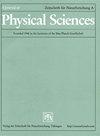Unveiling transport properties in rare-earth-substituted nanostructured bismuth telluride for thermoelectric application
IF 1.3
4区 物理与天体物理
Q4 CHEMISTRY, PHYSICAL
Zeitschrift Fur Naturforschung Section A-A Journal of Physical Sciences
Pub Date : 2023-10-09
DOI:10.1515/zna-2023-0162
引用次数: 0
Abstract
Abstract Thermoelectrics is an emerging technology in the field of renewable energy sources, and the exploration of doped materials has opened up new avenues for enhancing their performance. La-doped thermoelectric materials with the composition Bi 2− x La x Te 3 ( x = 0.0, 0.1, 0.2, 0.3, 0.4) were synthesized using the WOWS sol–gel method and sintered at 500 °C for 5 h. X-ray diffraction analysis confirmed a rhombohedral crystal structure with lattice constants of a = b = 4.41(2) Å and c = 29.81(3) Å. Scanning electron microscopy revealed particle-like shapes (0.7–2.5 μm). Fourier transform infrared spectroscopy confirmed the single-phase nature of the samples. DC electrical measurements showed increasing conductivity with temperature. AC electrical analysis demonstrated frequency-dependent behavior with increasing AC conductivity and decreasing loss factor and dielectric constants. Seebeck coefficient measurements exhibited temperature-dependent behavior. Thermal transport properties showed increasing thermal conductivity and volumetric specific heat with temperature, while thermal diffusivity decreased. The composition Bi 1.9 La 0.1 Te 3 with x = 0.1 doping displayed lower thermal conductivity, higher electrical conductivity, and a higher ZT value, making it more suitable for thermoelectric applications. Furthermore, the sample Bi 1.8 La 0.2 Te 3 exhibited favorable characteristics for energy storage applications compared to the other samples. These findings provide insights into the potential applications of La-doped bismuth telluride compounds in thermoelectric and energy storage systems.揭示稀土取代纳米结构碲化铋热电应用的输运性质
摘要:热电技术是可再生能源领域的新兴技术,掺杂材料的探索为提高热电材料的性能开辟了新的途径。采用WOWS溶胶-凝胶法合成了成分为Bi 2−x La x Te 3 (x = 0.0, 0.1, 0.2, 0.3, 0.4)的La掺杂热电材料,并在500℃下烧结5 h。x射线衍射分析证实了其晶格常数为a = b = 4.41(2) Å和C = 29.81(3) Å的菱形晶体结构。扫描电镜显示颗粒状(0.7 ~ 2.5 μm)。傅里叶变换红外光谱证实了样品的单相性质。直流电测量显示电导率随温度升高而增加。交流电学分析表明,随着交流电导率的增加,损耗因子和介电常数的降低,频率依赖性增强。塞贝克系数测量显示出温度依赖行为。热输运性能随温度升高,导热系数和体积比热增大,而热扩散系数减小。掺杂x = 0.1的Bi 1.9 La 0.1 Te 3具有较低的导热系数、较高的导电性和较高的ZT值,更适合热电应用。此外,与其他样品相比,样品Bi 1.8 La 0.2 Te 3表现出良好的储能特性。这些发现为la掺杂碲化铋化合物在热电和储能系统中的潜在应用提供了见解。
本文章由计算机程序翻译,如有差异,请以英文原文为准。
求助全文
约1分钟内获得全文
求助全文
来源期刊
CiteScore
3.00
自引率
5.60%
发文量
81
审稿时长
3.3 months
期刊介绍:
A Journal of Physical Sciences: Zeitschrift für Naturforschung A (ZNA) is an international scientific journal which publishes original research papers from all areas of experimental and theoretical physics. Authors are encouraged to pay particular attention to a clear exposition of their respective subject, addressing a wide readership. In accordance with the name of our journal, which means “Journal for Natural Sciences”, manuscripts submitted to ZNA should have a tangible connection to actual physical phenomena. In particular, we welcome experiment-oriented contributions.

 求助内容:
求助内容: 应助结果提醒方式:
应助结果提醒方式:


